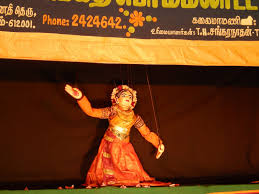In the Tamil language, Bomai meaning doll and Attam is dance -This is one of the simplest form of outdoor/indoor entertainment for children, even during my growing years, at schools, halls, market places, fairs, temples where the theme would be anything from Indian epics to moral stories to social issues. The ‘magically’ moving dolls on raised platform would keep the children riveted and tickle their innocent senses. But today, it is just another art form that has vanished into the web-world.
Bommalattam finds mention in the Sangam period (1 CE) literature and the itinerant puppeteer drew large crowd over centuries. Bommalattam combines the techniques of both rod and string puppets. The strings are tied to a ring which the handler wears like a crown on his head or some just hold the strings on hands. The jointed limbs of the puppets enable easy manipulation.
The Marionettes may be made of wood (kalyana murungai/moringa oleifera tree), leather, cloth or other materials. They are then painted, decked with rich ornaments, costumes and headdresses. The ones made of wood is heaviest of all though kalyana murungai wood is of lightweight nature. Generally, a single puppeteer hide behind the screen and manipulate the puppets from above while a small group assist him in handing over the right puppets at the appropriate times. Music, live or recorded accompany the show.
Only about 4 groups in southern Tamilnadu are trying to keep it going, with the patronage of state government and few private sources, and one such group from the town of Kumbakonam recently staged a show in the city of Chennai.
following are the images –



the following images are of Pinnal-Kollattam, pinnal meaning plait and kollattam mean stick-dance – another art form hardly seen these days. This art involves the dancers go around each other in intricate patterns, playing with the sticks, so that the coloured ropes hung from a single point above that they hold on to form into a plait as they dance around. And then they unravel the ropes by reversing the dance steps.




Clip of Rajasthani Puppet show
below is a video clip of Pinnal Kolattam (note: the dance ends at 11:13)

Mention could have been made about Tholu Pommalattam of Andhra as well as similar art in Indonesia. Rajasthan is quite famous for this art. In Tamilnadu this art is not finding much encouragement ,even in schools not many takers. May be Tamils like live characters only!!
LikeLike
Thanks for your feedback, Sri Rajan !
Well, as far as I know, it’s been traditionally wooden puppets in TN. I wonder if it has not wanting to do with leather, I’m not sure. I’m aware of the Andhra, Java and Rajasthani ones and had opportunity to watch them all. About a year ago, we had Andhra’s Tholu staged here in Chennai. But this particular blog piece is only about the shows that were staged recently and will try and do a separate piece on Tholu later.
LikeLike
It is interesting to see how similar cultural traditions have developed in different parts of the world, through different cultures, and yet they still show a clear resemblance 🙂
In Holland, we used to have similar puppet shows (one particular one was named after the main characters Jan-Klaas and his wife Katrijn – an ever-arguing couple), though usually they were hand puppets. The ribbon dance looks a lot like dancing around the May Pole, something that is very popular still in Sweden and other Scandinavian countries on Midsummer day.
LikeLike
Thanks for stopping by, Suze
Interesting to note the similarities, esp. the May-pole-dance. I recall seeing hand puppet shows when young,in the markets.
The human mind probably evolves in pretty similar pattern no matter where…and probably underlines we all are ONE and CONNECTED !
Thanks again for your time and comment !
LikeLike
Thanks for this post and the video. My kids and I enjoyed learning something!
LikeLike
Very happy to hear that – thanks for the visit !
LikeLike
Hi i m an assitant film maker….. I want to make a documentary about bommalattam can u help me ??? this is my ID (deepak45films@gmail.com) revert ASAP
LikeLike
Beautiful!
LikeLiked by 1 person
Thanks for the visit…will soon hope to post on leather puppets tradition in this part of the world 🙂
LikeLike